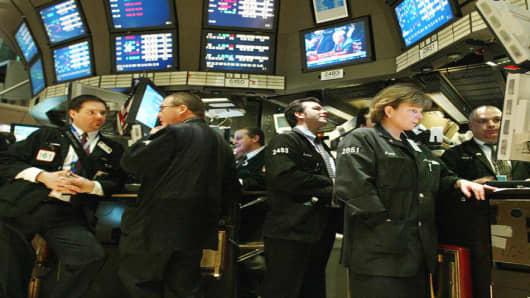Forget rate cuts and stimulus packages. In Wall Street's eyes, the recession is already here and the credit crunch is far from over.
This month's huge selloff in the stock market reflects the double-whammy being felt by investors: shrinking economic growth and continued uncertainty over the extent of the subprime mortgage mess.
This week, fourth-quarter earnings from Citigroupand Merrill Lynchwere the financial equivalent of a body count in a disaster. And the majority of economic indicators screamed slowdown, if not contraction.
No wonder, then, that a doom-and-gloom mentality unleashed enormous selling, sending the major stock indexes skidding between a ten-percent correction and 20 percent bear market.
The decidedly negative cocktail of corporate and economic numbers also generated new doubts about the wisdom of Federal Reserve’s interest rate policyas well as the effectiveness of its medicine.
"The Fed is getting blamed," says David Resler, chief economist at Nomura International. "There’s also the realization, in the financial markets, we’re seeing the market reaction to incredible uncertainty, the ignorance of how deep and the broad the problem is."
That problem is the "repricing" of an asset, broadly known as housing but more specifically a thorn of plenty including home prices, property, subprime loans, debt and any number of novel derivatives.
On top of that you have a normal deterioration in the business cycle, a relatively unproved Fed chairman and a presidential election year.
"People Don't Know"
The feeling I get is people don’t know how bad it is," says Sam Stovall, chief strategist at Standard & Poor’s. "That’s why we could see a day or two of counter-trend rally," which was briefly the case on Friday, when stocks opened sharply higher only to fall again.
Stovall says the market is entering a "typical pre-recessionary mode," citing statistics showing that the stock market has anticipated every one of the 11 recessions since WW II.
Playing that out, stocks typically fall from their high nine and a half months before the onset of a recession, bottoming out six months into the recession for an average decline of 26 percent from top to bottom.
Using that model, this time around, stocks have been falling since their Oct. 9 record high, a recession will start in July and the market will touch bottom in January 2009.
Going into Friday’s trading, the S&P 500 was 14.8 percent below its high four months ago. Stovall is quick to admit that the current Street consensus says if the economy suffers a recession this time around, it probably began in December 2007, which doesn't entirely jibe with the historical pattern.
Stovall says the market's woes are more about the credit crunch than the Fed. "Will the Fed really be able to do enough, quickly enough to undo all the negatives?"
Not Much to Do
Jim Awad, vice-chairman chairman of WP Stewart Asset Management, says there’s not much the Fed can or should do. Saying the write downs and credit issue transcend what the central bank can affect.
"The Fed should do one more thing cosmetically to show that they’re in it with us," he says, "There’s a school of though that they are pushing on a string short term and creating a problem long term."
Awad recommends investors "go with companies defensively-positioned domestically with leverage to high secular overseas growth," such as General Electric, parent of CNBC and CNBC.com, United Technologies, Kellogg and Procter & Gamble.
Other economists, analyst and money managers share Awad’s view that the credit crunch has to unwind, the balance sheet and economic problems need to be worked through and that there’s a certain amount of pain that is unavoidable, if not appropriate.
"What can the Fed do? Not a heck of a lot," says banking analyst Bert Ely, president of Ely & Co. "We’re working through a credit overhang. This is kind of what we had to do with the savings and loan crisis. Monetary policy doesn’t fix the problem."
The S&L crisis of the late 1980s and early 1990s is a useful example. Bad lending practices, troubled balanced sheets and a dose of fraud led to enormous losses in real estate and escalating estimates of what the problem would cost the economy, which later turned out to be wildly pessimistic
The stock market decline of 1990 –when stocks fell 20 percent between July and October of 1990 – and the recession of the time overlapped with the S&L debacle.
More Complicated Mess
Though there are some parallels, Ely and others say the current credit crunch is more complicated and potentially more damaging to the overall economy, even if the losses represent a smaller percentage of total GDP
"We don’t know how the mortgage problems are going to spill into other areas, such as credit cards and autos," worries Ely.
Those concerns are now being applied to bond insurers, whose stocks were battered this week. Both Ambac Financial Group and MBIA have attracted the attentionof credit agencies. Optimists can put to the fact that the bulk of the subprime losses, write downs and loan loss reserves may wind up being accounted for in the fourth quarter of 2007, reflecting both the brutal year in housing and the lending side.
"The damage is done, " says Ely. "The house burned down. We now have to rebuild the house. The fed is the fireman. Continuing to squirt water on it doesn’t do any good."




